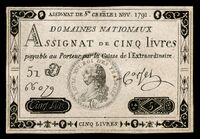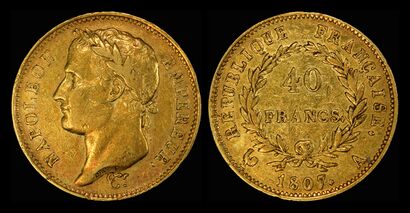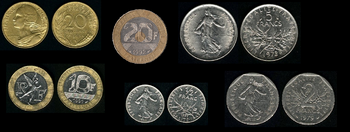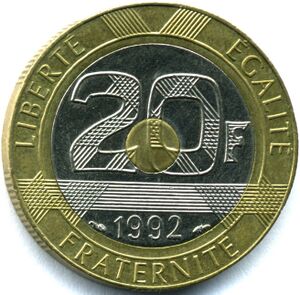فرنك فرنسي
| فرنك فرنسي | |||||
|---|---|---|---|---|---|
| franc français (فرنسية) | |||||
| |||||
| ISO 4217 | |||||
| الكود | FRF (1960–2002) | ||||
| الرقم | 250 | ||||
| الأس | 2 | ||||
| الفئات | |||||
| الوحدات الفرعية | |||||
| 1⁄100 | centime | ||||
| الرمز | F or Fr (briefly also NF during the 1960s; also unofficially FF and ₣) | ||||
| الكنية | balles (1 F);[1][n 1] sacs (10 F); bâton, brique, patate, plaque (10,000 F) | ||||
| الأوراق النقدية | |||||
| شائع الاستخدام | 20 F, 50 F, 100 F, 200 F, 500 F | ||||
| العملات | |||||
| شائع الاستخدام | 5, 10, 20 centimes, 1⁄2 F, 1 F, 2 F, 5 F, 10 F | ||||
| نادر الاستخدام | 1 centime, 20 F | ||||
| الديمغرافيا | |||||
| المستخدم(ون) | None; previously: France, Monaco, Andorra (until 2002); Saar, Saarland (until 1959) | ||||
| الإصدار | |||||
| البنك المركزي | Banque de France | ||||
| الموقع الإلكتروني | www | ||||
| مصلحة صك العملة | Monnaie de Paris | ||||
| الموقع الإلكتروني | www | ||||
| القيمة | |||||
| Pegged by | KMF, XAF & XOF, XPF, ADF, MCF | ||||
| ERM | |||||
| منذ | 13 March 1979 | ||||
| Fixed rate since | 31 December 1998 | ||||
| Replaced by €, non cash | 1 January 1999 | ||||
| Replaced by €, cash | 17 February 2002 | ||||
| € = | 6.55957 F | ||||
This infobox shows the latest status before this currency was rendered obsolete. | |||||
كان الفرنك الفرنسى العملة الرسمية لدولة فرنسا حتى عام 1999 وفي اليوم الأول من عام 1999 ولدت عملة اليورو رسمياً، واعتباراً من الرابع منه، فإن 80% من العملة المتداولة في الدول الداخلة في منطقة اليورو أصبحت العملة الموحدة: الدفع بين البنوك، وقروض الدولة، وكذلك أسعار الأسهم والادخارات باليورو، وقد بات ممكناً الدفع في عمليات الشراء بعملة اليورو بواسطة الشيكات. عام 2001 لم خرج الفرنك الفرنسي من التداول وتم استبداله باليورو نهائيا
التاريخ
The French Franc traces its origins to the Carolingian monetary system of the 8th century AD, and more specifically to the Livre Tournois, an offshoot of the same system which emerged in the 13th century. Here is a table of changes to the value of the Livre Parisis & the Livre Tournois in terms of silver or gold until the French Franc was introduced in 1795.
| Year | LP, g silver | LP, g gold | LT, g silver | LT, g gold |
|---|---|---|---|---|
| 781 | 407.92 | - | - | - |
| c 1000 | 305.94 | - | - | - |
| 1266 | - | - | 80.88 | - |
| 1317 | 80.88 | - | 64.70 | - |
| 1361 | 55.85 | 4.856 | 44.68 | 3.885 |
| 1425 | 38.243 | 3.585 | 30.594 | 2.868 |
| 1475 | 30.594 | 2.620 | 24.475 | 2.096 |
| 1549 | 20.396 | 1.747 | 16.317 | 1.398 |
| 1641 | - | - | 8.309 | 0.6189 |
| 1726 | - | - | 4.505 | 0.3116 |
| 1785 | - | - | 4.444 | 0.2867 |
| franc | - | - | 4.500 | 0.2903 |
الكارولنجي، 781
Emperor Charlemagne's monetary system was introduced in 781 AD to the Frankish Carolingian Empire & spread over the centuries to much of Western Europe, with a Livre (Pound) of silver divided into 20 Sols or Sous (Shillings) and the Sol divided into 12 Deniers (Penny). Only the denier existed as a coin for the next 500 years, with the sou & livre functioning as accounting multiples of the denier. The first livre & denier weighed 407.92 g & 1.7 g, respectively, of the finest silver available.
الثورة الفرنسية
The decimal "franc" was established as the national currency by the National Convention of Revolutionary France in 1795 as a decimal unit (1 franc = 10 décimes = 100 centimes) of 4.5 g of fine silver. This was slightly less than the livre of 4.505 g, but the franc was set in 1796 at 1.0125 livres (1 livre, 3 deniers), reflecting in part the past minting of sub-standard coins. Silver coins now had their denomination clearly marked as "5 FRANCS" and it was made obligatory to quote prices in francs. This ended the ancien régime's practice of striking coins with no stated denomination, such as the Louis d'or, and periodically issuing royal edicts to manipulate their value in terms of money of account, i.e. the Livre tournois. The franc became the official currency of France in 1799.[2]
الامبراطورية الفرنسية والاسترجاع
الاتحاد النقدي اللاتيني
France was a founding member of the Latin Monetary Union (LMU), a single currency employed primarily by the Romance-speaking and other Mediterranean states between 1865 and the First World War. The common currency was based on the franc germinal, with the name franc already being used in Switzerland and Belgium, whilst other countries minted local denominations, redeemable across the bloc with 1-to-1 parity, though with local names: e.g., the peseta. In 1873, the LMU went over to a purely gold standard of 1 franc = 0.290322581 grams of gold.
الحرب العالمية الأولى

The outbreak of World War I caused France to leave the gold standard of the LMU. The war severely undermined the franc's strength: war expenditure, inflation and postwar reconstruction, financed partly by printing ever more money, reduced the franc's purchasing power by 70% between 1915 and 1920. After a brief appreciation of the franc during the Depression of 1920–1921, it depreciated a further 43% between 1922 and a balancing of the budget in 1926. This devaluation was aggravated by the insistence of the Republican U.S. federal government and World War Foreign Debts Commission that France's war debts be repaid within 25 years at a minimal 4.25 percent interest per year. The currency devaluation contributed to French demands for high reparations payments from Germany.[3] After a brief return to the gold standard between 1928 and 1936, the currency was allowed to resume its slide, until in 1959 it was worth less than 2.5% of its 1934 value.
الحرب العالمية الثانية

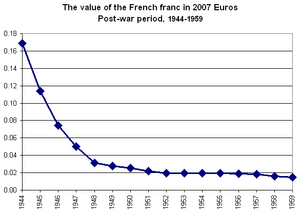
After the Liberation, the US attempted to impose the use of the US occupation franc, which was averted by General De Gaulle.
فترة ما بعد الحرب
After World War II, France devalued its currency within the Bretton Woods system on several occasions. Beginning in 1945 at a rate of 480 francs to the British Pound (119.1 to the U.S. dollar), by 1949 the rate was 980 to the Pound (350 to the Dollar). This was reduced further in 1957 and 1958, reaching 1382.3 to the Pound (493.7 to the Dollar, equivalent to 1 franc = 1.8 mg pure gold).
الفرنك الجديد

In January 1960 the French franc was revalued, with 100 existing francs making one nouveau franc.[4] The abbreviation "NF" was used on the 1958 design banknotes until 1963. Old one- and two-franc coins continued to circulate as new centimes (no new centimes were minted for the first two years). The one-centime coin never circulated widely. Inflation continued to erode the franc's value: between 1950 and 1960, price levels increased 72 per cent (5.7% per year on average); between 1960 and 1970, it increased 51 per cent (4.2%).[5] Only one further major devaluation occurred (11% in August 1969) before the Bretton Woods system was replaced by free-floating exchange rates. When the Euro replaced the franc on 1 January 1999, the franc was worth less than an eighth of its original 1960 purchasing power.[بحاجة لمصدر]
After revaluation and the introduction of the new franc, many French people continued to use the term "old francs" (anciens francs) for large sums, for example for the prices of houses, apartments, and cars. This was common until the introduction of the euro and even later. Many people, old and young – even those who had never used the old franc – still quoted prices in old francs, confusing tourists and people abroad.[6][7][8] For example, lottery prizes were most often advertised in amounts of centimes, equivalent to the old franc, to inflate the perceived value of the prizes at stake. Multiples of 10NF were occasionally referred to as "mille francs" (thousand francs) or "mille balles" ("balle" being a slang word for franc) in contexts where it was clear that the speaker did not mean 1,000 new francs. The expression "heavy franc" (franc lourd) was also commonly used to designate the new franc.[بحاجة لمصدر]
All franc coins and banknotes ceased to be legal tender in January 2002, upon the official adoption of the Euro.[بحاجة لمصدر]
الاتحاد الاقتصادي والنقدي
From 1 January 1999, the value exchange rate of the French franc against the Euro was set at a fixed parity of €1 = 6.55957 F. Euro coins and notes replaced the franc entirely between 1 January and 17 February 2002.[بحاجة لمصدر]
النقود
قبل الحرب العالمية الأولى
In August 1795, the Monetary Law replaced the livre ("pound") with the franc, which was divided into 10 décimes ("tenths") and 100 centimes ("hundredths"). Copper coins were issued in the denominations of 1 centime, 5 centimes, 1 décime, and 2 décimes, designed by Augustin Dupré. After 1801, French copper coins became rare.[بحاجة لمصدر]
من الحرب العالمية الثانية إلى إصلاح العملة

الفرنك الجديد
In 1960, the new franc (nouveau franc) was introduced,[9] worth 100 old francs. Stainless steel 1 and 5 centimes, aluminium-bronze 10, 20, and 50 centimes, nickel 1 franc and silver 5 francs were introduced. Silver 10-franc coins were introduced in 1965, followed by a new, smaller aluminium-bronze 5-centime and a smaller nickel 1⁄2-franc coin in 1966.[بحاجة لمصدر]
A first attempt to introduce a nickel 2-franc coin in 1960 failed.[بحاجة لمصدر]
Nickel-clad copper-nickel 5-franc and nickel-brass 10-franc coins replaced their silver counterparts in 1970 and 1974, respectively. Nickel 2 francs were finally introduced in 1979, followed by bimetallic 10 francs in 1988 and trimetallic 20 francs in 1992. The 20-franc coin was composed of two rings and a centre plug.[بحاجة لمصدر]
| 20 Centime with Marianne on Obverse. | |
|---|---|
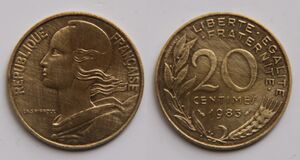
| |
| Obverse: Marianne wearing the Phrygian cap of liberty | Reverse: Face value and French motto: "Liberté, égalité, fraternité" |
| This coin was minted from 1962 to 2001. | |
All French franc coins were demonetized in 2005 and are no longer redeemable at the Banque de France.
At the time of the complete changeover to the euro on 1 January 2002, coins in circulation (some produced as recently as 2000) were:
| Circulation Coins of the French franc (valid in 2001) | ||||||||
|---|---|---|---|---|---|---|---|---|
| Image | Value | Equivalent in euros | Diameter | Weight | Material | Obverse | Reverse | Dates of issue |
| 1 centime | €0.0015 | 15 mm | 1.65 g | stainless steel | sheath of wheat | denomination | 1960–2001 | |
| 5 centimes | €0.0075 | 17 mm | 2.00 g | aluminum-bronze | Marianne and title of the country | denomination; national motto (Liberté, Egalité, Fraternité); date | 1966–2001 | |
| 10 centimes | €0.015 | 20 mm | 3.00 g | 1962–2001 | ||||
| 20 centimes | €0.030 | 23.5 mm | 4.00 g | 1962–2001 | ||||
| 1⁄2 franc | €0.076 | 19.5 mm | 4.50 g | nickel | The Sower; country name | denomination; olive branch; date; national motto (Liberté, Egalité, Fraternité) | 1965–2001 | |
| 1 franc | €0.152 | 24 mm | 6.00 g | 1960–2001 | ||||
| 2 francs | €0.305 | 26.6 mm | 7.50 g | 1979–2001 | ||||
| 5 francs | €0.760 | 29.0 mm | 10.0 g | nickel-clad cupronickel | 1970–2001 | |||
| 10 francs | €1.52 | 22.3 mm | 6.50 g | aluminum-bronze (ring); nickel (core) | "RF"; Le Génie de la Liberté | value; abstract pattern; date; national motto (Liberté, Egalité, Fraternité) | 1988–2001 | |
| 20 francs | €3.05 | 27.0 mm | 9.00 g | aluminum-bronze (outer ring and core); nickel (middle ring) | Country name; Mont-Saint-Michel | value; abstract pattern; date; national motto (Liberté, Egalité, Fraternité) | 1992–2001 | |
- 1 centime (~ 0.15 euro cents) stainless steel, rarely circulated (last production stopped first in 1982, then in 1987 due to high production cost, and lack of demand due to its very low value).
- 5 centimes (~ 0.76 cents) aluminium-bronze
- 10 centimes (~ 1.52 cents) aluminium-bronze
- 20 centimes (~ 3.05 cents) aluminium-bronze
- 1⁄2 franc (~ 7.6 cents) nickel
- 1 franc (~ 15.2 cents) nickel
- 2 francs (~ 30.5 cents) nickel
- 5 francs (~ 76 cents) nickel-clad copper-nickel
- 10 francs (~ €1.52) bimetallic
- 20 francs (~ €3.05) trimetallic, rarer (produced for a short period before the euro, the banknote equivalent was much more frequently used)
- 100 francs (~ €15.24) silver, rarely circulated (most often bought and offered as personal gifts, but rare in commercial transactions, now worth more than its face value).
الأوراق النقدية
10-franc banknote (1976) (front) Hector Berlioz
10-franc banknote (1976) (back) Hector Berlioz
20-franc banknote (1983) (front) Claude-Achille Debussy
20-franc banknote (1983) (back) Claude-Achille Debussy
50 francs Antoine de Saint-Exupéry
100 francs Eugène Delacroix
100 francs Paul Cézanne
200 francs Gustave Eiffel
500 francs Marie Curie and Pierre Curie
| Banknotes of the French franc (1993–1997 issue) | ||||||||
|---|---|---|---|---|---|---|---|---|
| Image | Value | Equivalent in euros | Size | Obverse | Reverse | Watermark | Remark | Date of issue |
| [10] | 50 F | €7.62 | 123 x 80 mm | Antoine de Saint-Exupéry; Le Petit Prince (The Little Prince); "Latécoère 28" airplane | "Breguet 14" biplane | Antoine de Saint-Exupéry | In the notes printed in 1992–1993, the name of Saint-Exupéry was misspelled as Éxupéry at upper left on front | 20 October 1993 |
| [11] | 100 F | €15.24 | 133 x 80 mm | Paul Cézanne | Fruit (a painting by Paul Cézanne) | Paul Cézanne | EURion constellation on the upper right corner of the note's reverse consisting of 100s spread across. | 15 December 1997 |
| [12] | 200 F | €30.49 | 143 x 80 mm | Gustave Eiffel; truss of the Eiffel tower | Base of the Eiffel tower | Gustave Eiffel | 29 October 1996 | |
| [13] | 500 F | €76.22 | 153 x 80 mm | Marie Curie and Pierre Curie | Laboratory utensils | Marie Curie | 22 March 1995 | |
De facto currency
Along with the Spanish peseta, the French franc was also a de facto currency used in Andorra (which had no national currency with legal tender). It circulated alongside the Monegasque franc in Monaco, with which it had equal value. These currencies were all replaced by the euro in 2002.
See also
Notes
- ^ Always used in the plural and originally in reference to the old franc, so that new francs were known as cent balles (100 old francs). Later, new francs and eventually euros came to be called " balles".
References
Citations
- ^ de Goncourt, E. & J. (1860), Charles Demailly, p. 107.
- ^ خطأ استشهاد: وسم
<ref>غير صحيح؛ لا نص تم توفيره للمراجع المسماةBritannica - ^ Steiner, Zara (2005). The lights that failed : European international history, 1919-1933. Oxford: Oxford University Press. ISBN 978-0-19-151881-2. OCLC 86068902.
- ^ "Ordonnance n°58-1341 du 27 décembre 1958 NOUVEAU FRANC". Legifrance/gouv/fr. Retrieved 5 أكتوبر 2017.
- ^ Otmar Emminger: DM, Dollar, Währungskrisen – Erinnerungen eines ehemaligen Bundesbankpräsidenten, 1986, p. 75.
- ^ [P]eople continued to talk in old Francs for large values. They were still doing that in January 2002... In everyday conversation many people around here now [in 2003] operate three different systems depending on the value involved. For prices up to around €100 Euros are used. For higher values Francs are used - New Francs that is, except for values of 10,000 New Francs and more, which are still quoted in old Francs. The French Franc and its replacement by the Euro on www.midi-france.info
- ^ "But everyone gets confused above 10 million francs [100 000 new francs] and continues to use 'old francs'." (Mais au-delà de 10 MF, tout le monde s'y perd et continue de parler en «anciens francs».) [1]
- ^ "Almost 40 years later, a large part of the population continues to talk in old francs!" (Près de quarante ans après, une grande partie de la population continue à parler en anciens francs !) [2]
- ^ 1958 Monetary Law Reform voted along with the Fifth Republic Constitution.
- ^ "P-157". Banknote.ws. Retrieved 5 أكتوبر 2017.
- ^ "P-158". Banknote.ws. Retrieved 5 أكتوبر 2017.
- ^ "P-159". Banknote.ws. Retrieved 5 أكتوبر 2017.
- ^ "P-160". Banknote.ws. Retrieved 5 أكتوبر 2017.
Bibliography
- Cuhaj, George S., ed. (2009). Standard Catalog of World Coins 1801–1900 (6th ed.). Krause. ISBN 978-0-89689-940-7.
External links
- Overview of French franc from the BBC
- Banknotes of France
- French franc (1951–1999) and euro (1999–ongoing) inflation calculators and charts
- Banknotes of France: Detailed Catalog of French Francs
- Historical banknotes of France (in إنگليزية and ألمانية)
| سبقه: Old franc سعر الصرف: 1 new franc = 100 old francs |
عملة France 1960 – 2002 |
تبعه: Euro السبب: deployment of euro cash النسبة: 1 euro = 6.55957 francs |
- Short description matches Wikidata
- Use dmy dates from July 2020
- Articles containing فرنسية-language text
- ISO 4217
- Articles with hatnote templates targeting a nonexistent page
- Articles with unsourced statements from June 2015
- مقالات ذات عبارات بحاجة لمصادر
- Articles with إنگليزية-language sources (en)
- Articles with ألمانية-language sources (de)
- Articles containing ألمانية-language text
- Economic history of France
- Modern obsolete currencies
- Medieval currencies
- Currencies replaced by the euro
- Currencies of Europe
- Currencies of Andorra
- 1860 establishments in France
- 2001 disestablishments in France
- Currencies of Monaco
- Currencies of France
- Currency symbols
- عملات أوروبية




